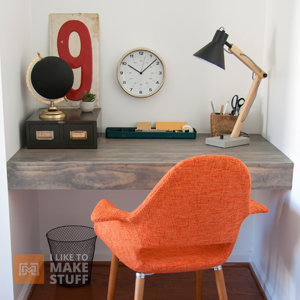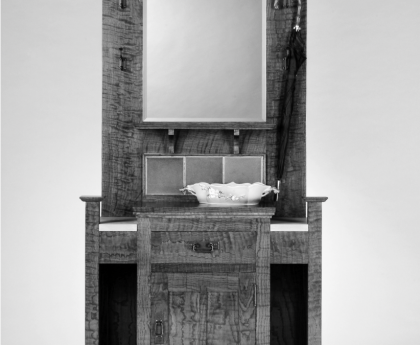
A good friend of mine is beginning to do interior design (as a job, she’s always done it in her own home which is beautiful) and one of her new clients had a little nook perfect for a desk. She asked me to make a little floating desk to fit there but the kicker was that I couldn’t get into the space until the time that I could install it (due to other work being done and my schedule).
She took really good measurements and gave good simple direction for what she was envisioning. It turned out to be a very simple build, but to great effect. She was really happy with it, and I think it fit the space perfectly. You could easily adapt the same thing to a similar small space in your house!
Tools List:
(purchasing via these affiliate links supports ILTMS)
The internal frame was made out of 2×4. I cut two long pieces for the front and back as well as three shorter pieces.

I predrilled and countersunk holes in the long pieces to attach them.

These pieces got screwed together to form a large box.

The center piece was added for a little extra support.

I laid out pieces of 1×4 and marked the center point of each.

These pieces all got cut in half on the miter saw.

I laid the pieces onto the frame and arranged them so that the difference in grain was really apparent, from piece to piece.

I made marks crossing two pieces in an offset pattern across all of the pieces. These are markings for where biscuit slots needed to be cut. The also help line the boards up again when assembling.

I used a biscuit joiner to cut a slot centered on each mark on every board.

I added plenty of glue to all of the edges of the boards as well as down inside all of the slots.

Then I added a biscuit to each slot. These also got covered with glue to help fill the mating slot with glue.

I lined up all of the biscuits and slots then clamped the boards together. I alternated the clamps from the top and bottom to help prevent buckling in either direction.

After it was dried, I used a scraper to pop off the excess glue squeeze out.

Then I used a hand plane to help even out the difference in height between the joints.

For the desk front, I ripped down a 1×6 to the current width and chopped to length to fit the desk top.

Holding it up to the desk top, I marked for biscuits across the joint.

I cut the slots as before, then added glue and biscuits.

I clamped the front to the top and made six marks, evenly spaced 3/8″ from the top surface (this is 1/2 the depth of the top panel.)

On these marks I drilled and counter sunk a hole, then added a screw.

I added a dowel, covered with glue to each hole.

These were all trimmed off with a flush cut saw.

I planed and sanded down the joint on the top surface after the glue was completely dried.

To even up one side, I used a speed square on the front edge to set a straight edge perpendicular to the front face. I clamped it down and used it as a guide for the circular saw.

The front panel was trimmed up with a hand saw.

From that straight edge, I measured the final with of the desk and cut off the excess in the same ways as before.

The client asked for a “classic grey” stain, so I applied it liberally, waited about five minutes, then wiped it off.

The surface got two coats of polycrylic with a light sanding in between.

The last thing to cut was a piece of 1/8″ plywood sized to match the frame.

To install the desk, I marked the final height, then 3/4″ (this thickness of the desk top) below that mark. This would be the top of the frame.

I set a laser level on the lower mark so that it shown on all three walls.

Since I would be covering parts of the laser while installing, I made several marks on that line on each wall.

I lined up the top of the frame with those marks and added screws through the frame into areas where I knew there was a stud.

There are typically studs in the corners as well, so I drove long screws into the back corners of the frame as well.

To add more security, I drilled through the frame and drove in some anchoring screws into the sheetrock. I sat on the frame to test it, and it was solid.

It took a little knocking and trimming but I got the desk fit into the slot on top of the frame.

I secured it with screws through the front of the frame, into the face plate of the desk top. I also angled some screws in the back connecting the frame and the top.

I attached the plywood sheet underneath with some screws. I didn’t have time to stain this beforehand, but stained it after the project was completed.

Here it is!

The post How to make a floating desk appeared first on I Like to Make Stuff.
SOURCE: I Like to Make Stuff – Read entire story here.



